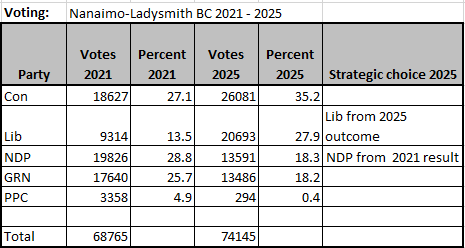The 2025 voting results from the riding of Nanaimo – Ladysmith in British Columbia are reviewed here as a good example for discussion purposes and are not intended to single out the riding or the voters who live there.
Nanaimo – Ladysmith in 2021 elected an NDP candidate by a narrow margin over Conservative and Green candidates. The application of “strategic” progressive voting in 2025 would have suggested (incorrectly as it turns out) the NDP candidate as the one to back. In fact, both the NDP and Greens lost support while the Liberals gained, but the Conservatives also gained votes and won.

There appears to have been strategic voting applied against the NDP and Greens in favour of the Liberals, however there was still sufficient splitting of the progressive vote to allow the Conservatives to win.
What other observations can be drawn from the Nanaimo-Ladysmith voting patterns? There is a plurality of opinion and party support with 4 parties receiving substantial support, and healthy voter engagement. Voters do not appear to have been only interested in strategic voting.
The Nanaimo – Ladysmith 2025 results are the kind of outcome that supports Proportional Representation instead of first-past-the-post. Proportional representation represents the voter’s desire path.
In the 2025 federal election, many voters were swayed to vote against the conservatives by “outside influences”, the potential threat to the Canadian democratic political system of the type that is occurring in the United States.
Advocating strategic voting makes the argument that “defeating x or achieving y” is more important than voter engagement or plurality of opinion.
Engagement of the public in the voting process is critical for acceptance of public participation as worthwhile, and as a bulwark against manipulation by external self-interests/actors.
So, where does this leave Strategic Voting? As a last resort.
